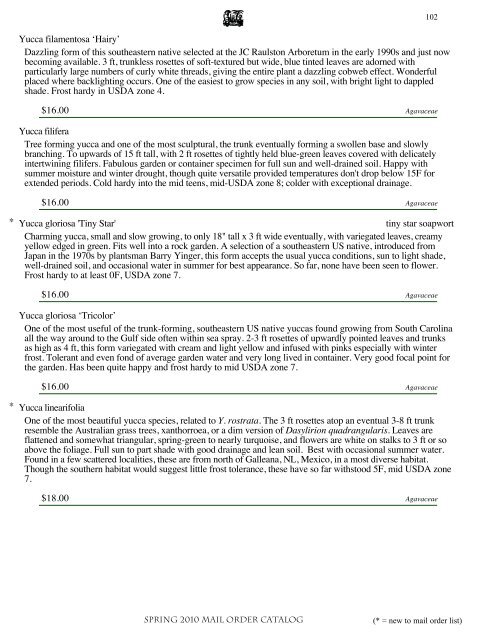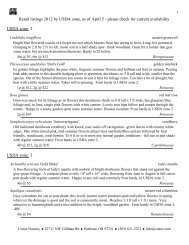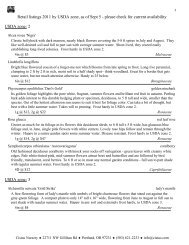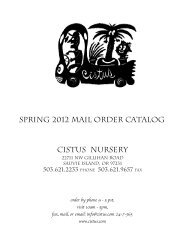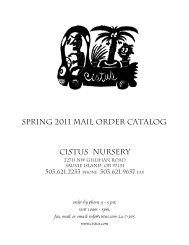Mail Order Catalog Fall 2010 - Cistus Nursery
Mail Order Catalog Fall 2010 - Cistus Nursery
Mail Order Catalog Fall 2010 - Cistus Nursery
Create successful ePaper yourself
Turn your PDF publications into a flip-book with our unique Google optimized e-Paper software.
Yucca filamentosa ‘Hairy’<br />
Dazzling form of this southeastern native selected at the JC Raulston Arboretum in the early 1990s and just now<br />
becoming available. 3 ft, trunkless rosettes of soft-textured but wide, blue tinted leaves are adorned with<br />
particularly large numbers of curly white threads, giving the entire plant a dazzling cobweb effect. Wonderful<br />
placed where backlighting occurs. One of the easiest to grow species in any soil, with bright light to dappled<br />
shade. Frost hardy in USDA zone 4.<br />
$16.00<br />
102<br />
Agavaceae<br />
Yucca filifera<br />
Tree forming yucca and one of the most sculptural, the trunk eventually forming a swollen base and slowly<br />
branching. To upwards of 15 ft tall, with 2 ft rosettes of tightly held blue-green leaves covered with delicately<br />
intertwining filifers. Fabulous garden or container specimen for full sun and well-drained soil. Happy with<br />
summer moisture and winter drought, though quite versatile provided temperatures don't drop below 15F for<br />
extended periods. Cold hardy into the mid teens, mid-USDA zone 8; colder with exceptional drainage.<br />
$16.00<br />
$16.00<br />
Agavaceae<br />
* Yucca gloriosa 'Tiny Star' tiny star soapwort<br />
Charming yucca, small and slow growing, to only 18" tall x 3 ft wide eventually, with variegated leaves, creamy<br />
yellow edged in green. Fits well into a rock garden. A selection of a southeastern US native, introduced from<br />
Japan in the 1970s by plantsman Barry Yinger, this form accepts the usual yucca conditions, sun to light shade,<br />
well-drained soil, and occasional water in summer for best appearance. So far, none have been seen to flower.<br />
Frost hardy to at least 0F, USDA zone 7.<br />
Agavaceae<br />
Yucca gloriosa ‘Tricolor’<br />
One of the most useful of the trunk-forming, southeastern US native yuccas found growing from South Carolina<br />
all the way around to the Gulf side often within sea spray. 2-3 ft rosettes of upwardly pointed leaves and trunks<br />
as high as 4 ft, this form variegated with cream and light yellow and infused with pinks especially with winter<br />
frost. Tolerant and even fond of average garden water and very long lived in container. Very good focal point for<br />
the garden. Has been quite happy and frost hardy to mid USDA zone 7.<br />
$16.00<br />
$18.00<br />
Agavaceae<br />
* Yucca linearifolia<br />
One of the most beautiful yucca species, related to Y. rostrata. The 3 ft rosettes atop an eventual 3-8 ft trunk<br />
resemble the Australian grass trees, xanthorroea, or a dim version of Dasylirion quadrangularis. Leaves are<br />
flattened and somewhat triangular, spring-green to nearly turquoise, and flowers are white on stalks to 3 ft or so<br />
above the foliage. Full sun to part shade with good drainage and lean soil. Best with occasional summer water.<br />
Found in a few scattered localities, these are from north of Galleana, NL, Mexico, in a most diverse habitat.<br />
Though the southern habitat would suggest little frost tolerance, these have so far withstood 5F, mid USDA zone<br />
7.<br />
Agavaceae<br />
Spring <strong>2010</strong> <strong>Mail</strong> <strong>Order</strong> <strong>Catalog</strong> (* = new to mail order list)


